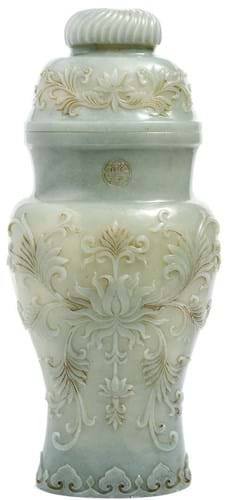
Matthew Barton – November 21
Jade was one of the great passions of the emperor Qianlong. He particularly admired the jades from northern India and established workshops for the production of Mughal-style jades in the grounds of his palace.
A Swiss collection of mostly 18th century Chinese celadon jades inspired by those exported from Mughal territory in India forms part of Matthew Barton’s sale of European and Asian Works of Art, held on November 21 at 25 Blythe Road in West Kensington. The group of more than 60 pieces features an array of sceptres, vases, fans, seals, court necklaces and snuff bottles ranging in price from £100-12,000. This Mughal-style greyish celadon jade ‘lotus’ vase is guided at £3000-5000.
Ewbank’s – November 8
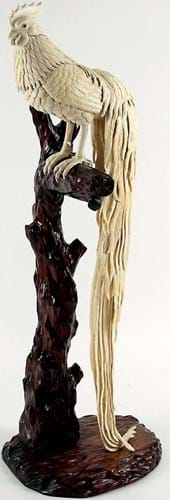
Ewbank’s sale of Asian art on November 8 in Surrey will include this late Meiji period 2ft 6in (75cm) ivory figure of a fighting cockerel with mother-of-pearl eyes, pictured right. Estimate £2500-3500.
According to ancient Japanese myth, it was a cockerel who lured the sun goddess, Amaterasu, out of her cavern where she had been hiding, bringing light back to the sky. The cockerel is thus a symbol of courage.
Ewbank’s sale of Asian art on November 8 in Surrey will include this late Meiji period 2ft 6in (75cm) ivory figure of a fighting cockerel with mother-of-pearl eyes, pictured above. Estimate £2500-3500.
Fellows – December 3
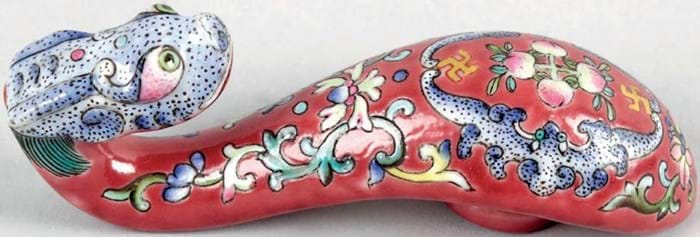
Among the Asian entries to Fellows’ auction on December 3 is this richly decorated porcelain painted belt hook, guided at £400-600.
Among the Asian entries to Fellows’ auction on December 3 is this richly decorated porcelain painted belt hook, above.
Used in China from at least as early as 700BC to fasten robes or, later, trousers when the use of horses became more common, the belt hook formed a simple buckle by attaching one end of the belt or girdle with a projecting prong or button to hook into the other end of the belt.
This example possibly dates to the Qianlong period and carries an estimate of £400-600 in the Birmingham sale.
Hannam’s – October 30-November 1
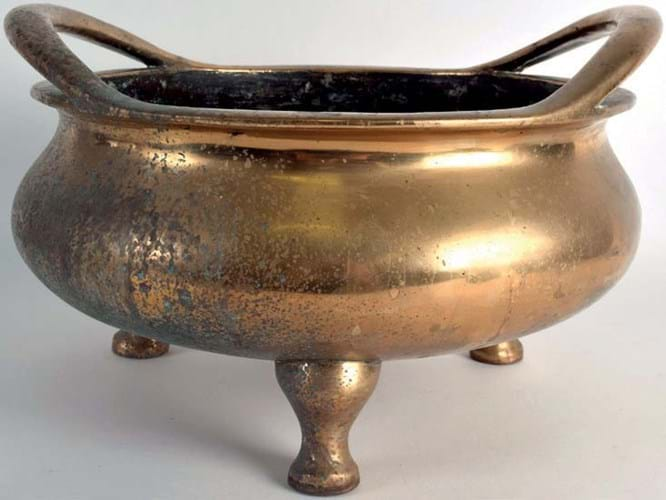
This large 18th or 19th century Qing twin-handled bronze censer will go under the hammer at Hannam’s on October 30-November 1 estimated at £300-500.
Discovered in a UK house clearance, this large 18th or 19th century Qing twin-handled bronze censer will go under the hammer at Hannam’s on October 30-November 1.
The hefty 15in (39cm) wide piece bears a rare version of the Xuande mark and weighs 5.5kg.
Estimate £300-500.
Duke Street – November 4
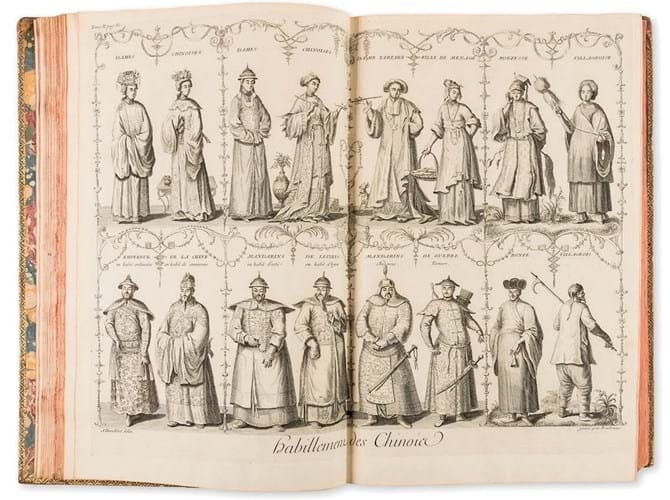
As part of the Association of Accredited Auctioneers (AAA) event, which takes place on November 4 in Duke Street, SW1, London saleroom Forum Auctions will be selling this first edition China-centric book in four volumes, priced at £15,000.
Timed to coincide with Asian Art in London’s late-night opening in St James’s, six regional salerooms under the Association of Accredited Auctioneers (AAA) banner will hold a viewing event showcasing forthcoming auction highlights of Asian works of art, jewellery, prints and memorabilia.
As part of the event, which takes place on November 4 in Duke Street, SW1, London saleroom Forum Auctions will be selling this first edition China-centric book in four volumes, priced at £15,000.
Formerly owned by the rare book collector Frank Streeter, Description Geographique, Historique, Chronologique, Politique et Physique de l’Empire de la Chine by Jean Baptiste Du Halde was published in 1735. It is one of the earliest European sources on Chinese ceramics and for the first time brought together accounts of the travels of a number of Jesuits throughout China.
Mallams – October 31
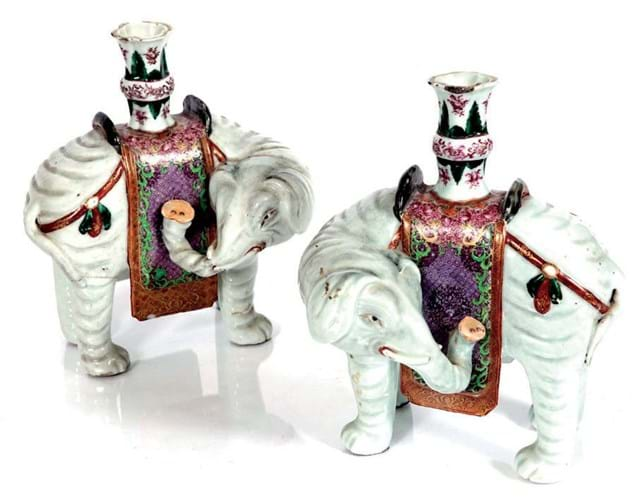
These 9½in (24cm) high white-glazed elephants were made for the Western market during the reign of the Qianlong emperor. They are estimated together at £1000-1500 in a sale of Chinese and Japanese art at Mallams in Cheltenham on October 31.
In the 18th century the term ‘Made in China’ was a mark of sophistication among Western porcelain enthusiasts. These 9½in (24cm) high white-glazed elephants were made for the Western market during the reign of the Qianlong emperor. They are estimated together at £1000-1500 in a sale of Chinese and Japanese art at Mallams in Cheltenham on October 31.
Dreweatts – November 12

This late 19th century ‘kesi’ dragon robe is part of a small collection of textiles going under the hammer at Dreweatts in Donnington Priory, Newbury, on November 12. Estimate £2500-3500.
The aniline purple found on this late 19th century ‘kesi’ dragon robe would have made a statement in the later Qing court. Worn by a high-ranking mandarin, it is woven with gold-threaded five-clawed dragons chasing the pearl of wisdom.
The robe comes from a small collection of textiles going under the hammer at Dreweatts in Donnington Priory, Newbury, on November 12. The group was assembled by the late Jean Cooper (1905-99), author of the 1970s publication An Illustrated Encyclopaedia of Traditional Symbols and Taoism, who spent her early years in northern China.
Estimate £2500-3500.
Brightwells – November 14-15
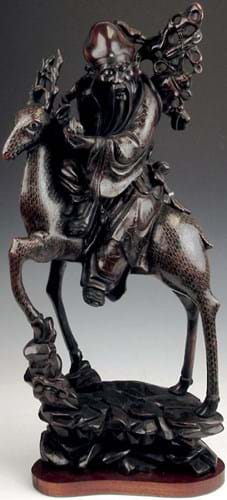
This hardwood carving of Shoulao is unusual for the late Qing dynasty. Brightwells of Leominster will offer the piece in a two-day fine art sale on November 14-15 estimated at £400-600.
With its extra silver embellishments, large size and subject matter, this 2ft 2in (65cm) high hardwood carving of Shoulao is unusual for the late Qing dynasty. The deity is depicted riding on the back of a deer – thought to be the only animal in China that can sniff out the highly-prized ‘lingzhi’ mushroom.
They are also symbolic of wealth as ‘lu’, the word for deer in Chinese, can also be translated as the salary of an official. Brightwells of Leominster will offer the piece in a two-day fine art sale on November 14-15.
Estimate £400-600.
Andrew Smith & Son – October 30-31
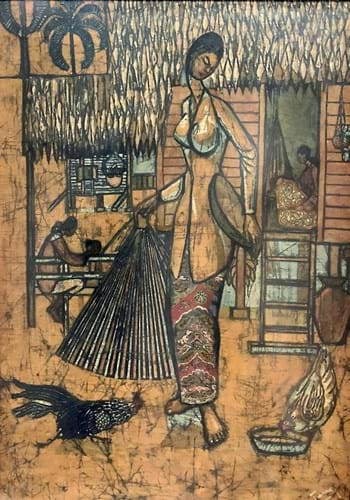
This 3ft x 2ft 1in (91 x 63cm) Batik portrait of three rural Malaysian women in a village by Chuah Thean Teng is guided at £1000-2000 in the Andrew Smith & Son October 30-31 auction.
Batik – the technique of wax-resist dyeing on cloth – is deeply steeped in Malaysian culture but it wasn’t until the 20th century with the creations of Chuah Thean Teng (1914-2008) that the traditional folk craft was turned into a fine art form.
Teng began to create batik paintings in 1953, after the closure of his commercial batik cloth factory in Penang. Unwilling to discard a large stock of leftover imported dyes, white cloth, wax and brushes, he began to dabble in figurative designs.
Two of his figurative batik works will go under the hammer at Andrew Smith & Son in Itchen Stoke, Hampshire, on October 30-31. They were inherited from the vendor’s father who served as a warrant officer with The Corps of Royal Electrical and Mechanical Engineers in Kuala Lumpur c.1960-65.
This 3ft x 2ft 1in (91 x 63cm) Batik portrait of three rural Malaysian women in a village is guided at £1000-2000.
Toovey’s – November 29
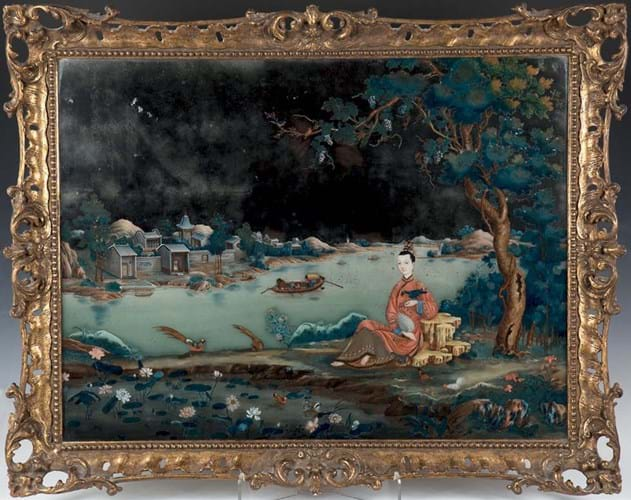
This Chinese export mirror reverse painting dates to the Qianlong period and is decorated with a lady seated on a rock beside a lotus pond. It is estimated at £30,000-50,000 at Toovey’s sale in Washington, West Sussex, on November 29.
With its vibrant colours and exotic flavour, Chinese export reverse glass painting was the height of fashionable sophistication in English country house collections in the 18th century.
This well-preserved Chinese export reverse mirror example dates to the Qianlong period and is decorated with a lady seated on a rock beside a lotus pond.
Housed within a carved and pierced rococo scroll openwork giltwood frame, the 23in x 2ft 6in (58 x 77.5cm) work is estimated at £30,000-50,000 at Toovey’s sale in Washington, West Sussex, on November 29.
Semley’s – November 10
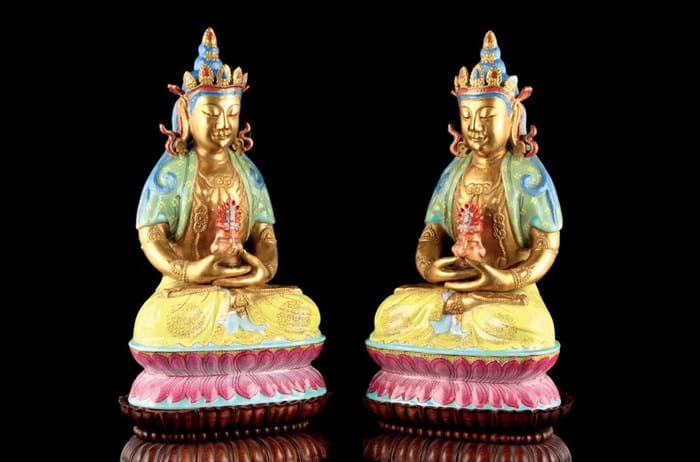
Semley’s Asian art sale in Shaftesbury on November 10 includes this pair of Qianlong/Jiaqing period (1736-1820) famille rose porcelain figures of Amitayus, estimated at £60,000-80,000.
Semley’s Asian art sale in Shaftesbury on November 10 includes this pair of Qianlong/Jiaqing period (1736-1820) famille rose porcelain figures of Amitayus, each modelled seated in dhyansana on an integral double lotus base, pictured above. With the addition of carved hongmu stands they measure 9in (22cm) high. The auctioneers say they come from a titled English family, then by descent to the present vendor, to whom these figures have been known since 1950. The estimate is £60,000-80,000.
Chorley’s – November 20-21
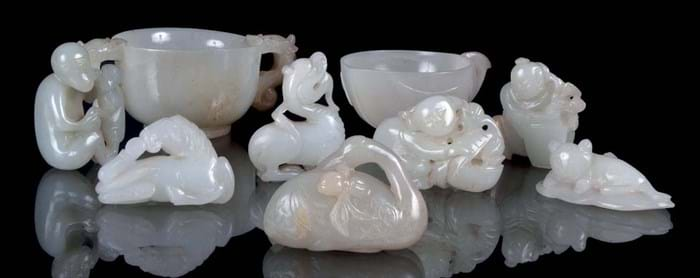
In a two-day sale on November 20-21, Cotswolds auction house Chorley’s will offer 20 jade carvings dating to the 18th and early 19th centuries.
In a two-day sale on November 20-21, Cotswolds auction house Chorley’s will offer 20 jade carvings dating to the 18th and early 19th centuries.
Made up of animals, birds, insects and flora and fauna, the group of handling pieces was assembled by the grandfather of a Cheltenham family in the early 20th century. Individual estimates include £2000-3000 for a jade of three kittens playing and £4000-6000 for a heron with its head extended along its back.
John Nicholson’s – November 21
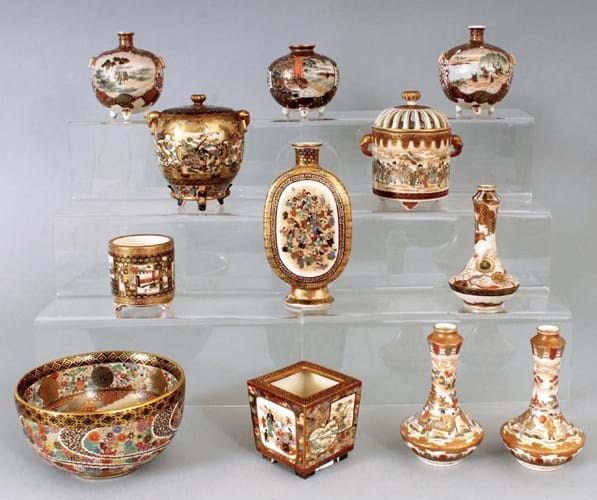
Surrey saleroom John Nicholson’s of Haslemere will include this private collection of Meiji period moon flasks, vases, pots and bowls, mostly painted for the studio by Kobayashi Keizan. Estimates range from £100-1000 in the auction on November 21.
Not all of Japan’s famed Satsuma ware was produced in Satsuma – the domain in southern Kyushu on the country’s third-largest island. The Kinkozan studio based in Kyoto became the largest overall producer of Satsuma export ware (especially to America) in the 19th century.
Surrey saleroom John Nicholson’s of Haslemere will include this private collection of Meiji period moon flasks, vases, pots and bowls, mostly painted for the studio by Kobayashi Keizan. Estimates range from £100-1000 in the auction on November 21.
Halls – November 28
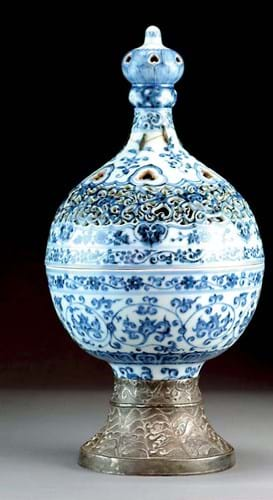
Among the ceramic pieces to go under the hammer at Halls’ November 28 sale in Shrewsbury, Shropshire, is this blue and white ‘flower and wave’ censer and cover, estimated at £30,000-50,000.
Among the ceramic pieces to go under the hammer at Halls’ November 28 sale in Shrewsbury, Shropshire, is this blue and white ‘flower and wave’ censer and cover. With a six-character Xuande mark, it was made during the Ming dynasty for the Persian market.
Estimate £30,000-50,000
Cheffins – November 8

This Han dynasty bronze lamp modelled as a snake is on offer at Cheffins of Cambridge on November 8, guided at £80,000-120,000.
Han dynasty bronze lamps of the type shown here usually come in the form of goose feet – this is thought to be the only known surviving example styled as a snake. Snakes were known to have been important in the ancient Chu Kingdom, having been discovered on the 5th century tombs of Zeng Hou Yi in the Hubei province in central China (one of only a handful of ancient Chinese royal tombs to have been discovered intact).
The piece has been consigned from a Hong Kong-based collector to Cheffins of Cambridge where it will be offered on November 8, guided at £80,000-120,000.














